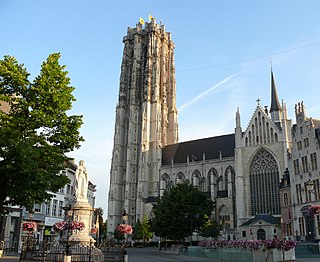
The Roman Catholic Archdiocese of Cambrai is an archdiocese of the Latin Rite of the Roman Catholic Church in France, comprising the arrondissements of Avesnes-sur-Helpe, Cambrai, Douai, and Valenciennes within the département of Nord, in the region of Nord-Pas-de-Calais. The current archbishop is Vincent Dollmann, appointed in August 2018. Since 2008 the archdiocese has been a suffragan of the Archdiocese of Lille.

Jacobus Pamelius was a Flemish theologian who was named bishop of Saint-Omer.

The Diocese of Namur is a Latin Church ecclesiastical territory or diocese of the Catholic Church in Belgium. It is a suffragan of the Archdiocese of Mechelen-Brussels. The diocese is a suffragan in the ecclesiastical province in the metropolitan Archdiocese of Mechelen-Brussels. Its cathedra is found within St Aubin's Cathedral in the episcopal see of Namur.

Saint Gaugericus, in French Saint Géry was a bishop of Cambrai, France.
The former French diocese of Thérouanne controlled a large part of the left bank of the river Scheldt during the Middle Ages. Territorially it was part of the county of Artois which belonged to the county of Flanders.

The Roman Catholic Diocese of Arras (–Boulogne–Saint-Omer) is a diocese of the Latin Rite of the Roman Catholic Church in France. The episcopal see is the Arras Cathedral, in the city of Arras. The diocese encompasses all of the Department of Pas-de-Calais, in the Region of Nord-Pas-de-Calais.

The Diocese of Tournai is a Latin Church ecclesiastical territory or diocese of the Catholic church in Belgium. The diocese was formed in 1146, upon the dissolution of the Diocese of Noyon & Tournai, which had existed since the 7th Century. It is now suffragan in the ecclesiastical province of the metropolitan Archdiocese of Mechelen-Brussels. The cathedra is found within the Cathedral of Notre-Dame de Tournai, which has been classified both as a major site for Wallonia's heritage since 1936 and as a World Heritage Site since 2000.
Gerard of Florennes, bishop of Cambrai as Gerard I, had formerly been chaplain to Henry II, Holy Roman Emperor, and helpful to the latter in his political negotiations with Robert the Pious, King of France. In 1024 Gerard called a synod in Arras to confront a purported heresy fomented by the Gundulfian heretics, who denied the efficacy of the Eucharist. The records of this synod, the Acta Synodi Atrebatensis, preserve a summary of orthodox Christian doctrine of the early eleventh century, as well contemporary peace-making practices. According to this text's author, the heretics were convinced by Gerard's explanation of orthodoxy, renounced their heresy, and were reconciled with the church.
Engelbert Des Bois (1578–1651) was the seventh bishop of Namur (1630–1651).

Ambrosius Capello (1597–1676) was the seventh bishop of Antwerp (1654–1676).

The Archdiocese of Mechelen–Brussels is a Latin Church ecclesiastical territory or archdiocese of the Catholic Church in Belgium. It is the primatial see of Belgium and the centre of the Ecclesiastical Province governed by the Archbishop of Mechelen-Brussels, which covers the whole of Belgium. It was formed in 1559 and the bishop has a seat in two cathedrals, St. Rumbold's Cathedral in Mechelen and the Cathedral of St. Michael and St. Gudula in Brussels. The current archbishop is Jozef De Kesel, who was installed in November 2015.
Jean Dauvin or D'Auvin (1578–1651) was the sixth bishop of Namur (1615–1629). As bishop he faced the tasks of carrying through the reforms of the Council of Trent in his diocese in the wake of the destruction caused by the Dutch Revolt.

Jean Sarazin, Latinized Joannes Saracenus (1539–1598) was an abbot of the Benedictine Abbey of St. Vaast, Arras, and the third archbishop of Cambrai.
Jean Six (1533–1586) was a theologian and bishop of Saint-Omer.

Martin Bauwens of Riethoven or Martinus Rythovius was a Catholic theologian and the first Bishop of Ypres. He was a figure of some spiritual and political significance during the early decades of the Dutch Revolt.
Thomas Sailly (1553–1623) was a Jesuit military chaplain and author of devotional writings in the Spanish Netherlands.
François Buisseret (1549–1615) was a clergyman from the Habsburg Netherlands who became bishop of Namur and archbishop of Cambrai.
Maximilian de Berghes was the first archbishop of Cambrai.

Franciscus van der Burch (1567–1644) was a bishop of Ghent and archbishop of Cambrai.
Mathieu Moulart (1536–1600), alternatively Moullart or Moulard, was an abbot and bishop in the Habsburg Netherlands.









